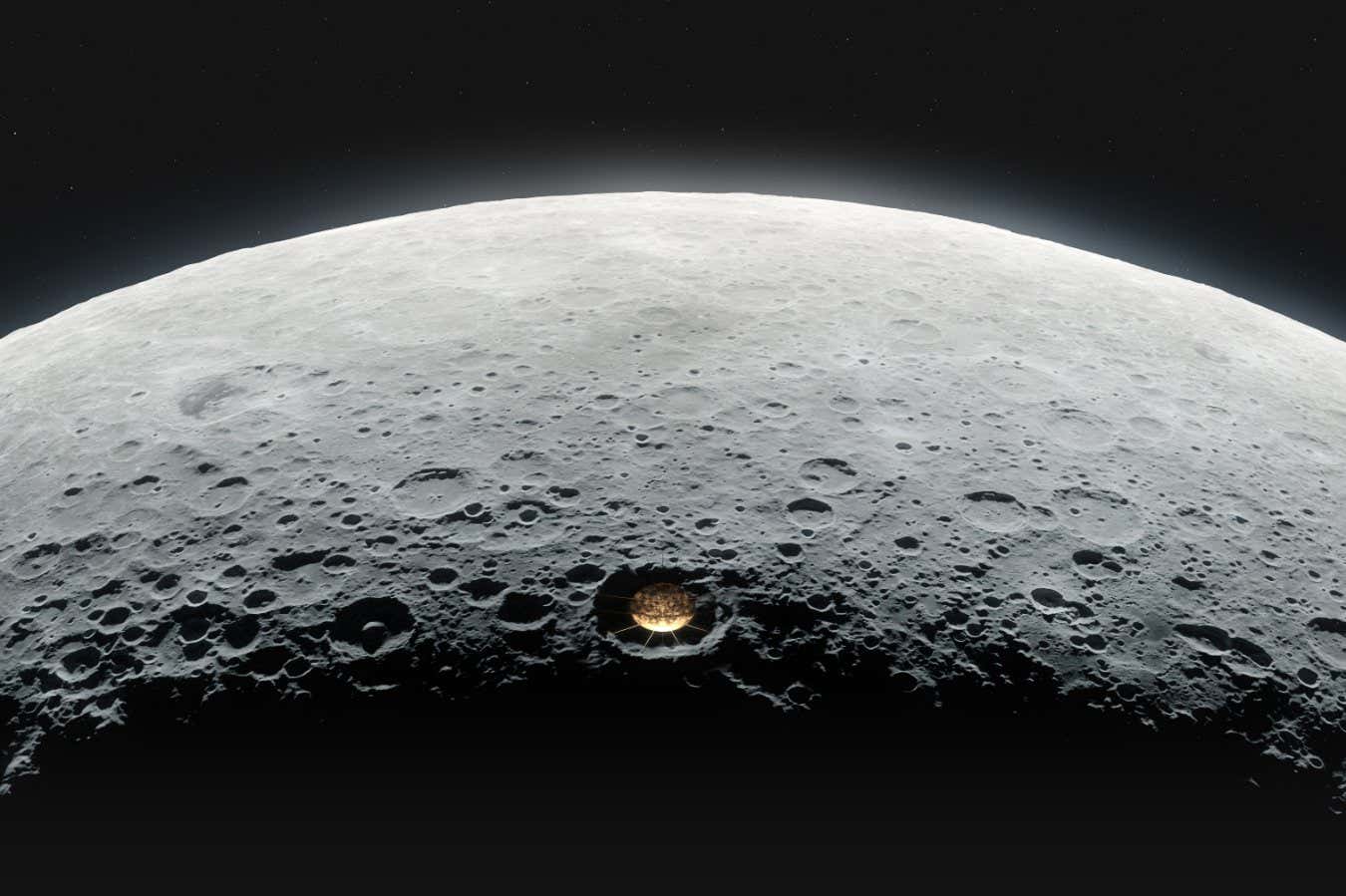
“In 2050 … the first 100 m-diameter telescope took shape in a crater on the lunar surface”
Vladimir Vustyansky/NASA
The All-Seeing Eye, which came into operation in the 2070s, was by far the largest and most powerful optical instrument ever built. Comprising eight telescopes built across the entire lunar surface, each with a 100-metre-diameter mirror, the effective aperture of the full, composite telescope was the size of the entire surface of the moon, enabling an unprecedented imaging ability.
For the first time, we could see the fabled “first light” – the birth of the first stars in the universe. We could also see surface features of exoplanets many light years away.
Several proposals had been made in the 2020s for ambitious, next-generation telescopes, but the capacity for large space-based projects wasn’t then in place. By the 2050s, however, transport to the moon had become routine and affordable, and construction on the lunar surface was well under way.
This was when an old 2020 proposal for what was called the Ultimately Large Telescope (ULT), with a 100-metre-diameter mirror, was dusted off and updated.
The ULT relied on a mirror made not of glass, but of liquid. Liquid was cheaper to transport to the moon and easier to construct and form into a perfectly reflective surface. In the lower gravity of the moon, it was possible to build a much larger mirror than on Earth or even in space, where anything larger than 10 m in diameter caused alignment headaches. The James Webb Space Telescope, which became operational in the 2020s, had a 6.5 m-diameter mirror.
On its own, a single ULT on the moon was powerful, but not quite powerful enough to resolve features and physical structures, such as buildings, on exoplanets. No matter: cunning astronomers had built the ULT with expansion in mind.
To increase its reach, a clever method used for radio telescopes, called very-long baseline interferometry (VLBI), was adapted for use in optical systems. VLBI had been used in 2017 by the Event Horizon Telescope collaboration to capture the first image of a supermassive black hole at the centre of our galaxy. The EHT worked by combining inputs from eight telescopes on Earth to increase the effective size of the telescope.
In 2025, scientists led by Zixin Huang at the Centre for Engineered Quantum Systems at Macquarie University in Australia worked out a way to use VLBI for optical telescopes. It took some years for technical, political and financial hurdles to be cleared, but serious plans to build a moon-sized optical telescope were drawn up in 2050 as the first 100 m-diameter telescope took shape in a crater on the lunar surface.
“
The telescope on the lunar surface saw back 13 billion years and imaged high-mass, first-generation stars
“
By 2075, seven more such telescopes had been constructed across the moon. Linked together, they formed a telescope with an effective mirror size of 3000 km.
In the mid-2020s, the James Webb had reached back in time to see the formation of the first galaxies. Now, the completed All-Seeing Eye revealed a near-mythical population of stars called population III. Stars are classified into various groups. Population I includes recent stars with an abundance of heavier elements, also known as high metal content, such as the sun in the Earth system. Population II stars are old and low in metal content, while population III stars are the first formed after the big bang, with low to no metal content. The big bang only created hydrogen and helium, and traces of lithium and beryllium; all the other, heavier elements needed stars to be forged. The All-Seeing Eye saw back 13 billion years and imaged high-mass, first-generation stars. One such giant early star, a blue gargantuan 100,000 times the mass of the sun, was named Zixin-1 after the astronomer who had done so much to develop optical VLBI.
The concept of a moon-sized telescope itself had gone by a number of names. Originally, in 2008, a team at the University of Arizona proposed the Lunar Liquid-Mirror Telescope, which became the Ultimately Large Telescope in 2020. The public, however, complained that the names of these and previous telescopes (the Extremely Large Telescope, the Thirty-Metre Telescope) were too boring. To avert the choice of Moony McMoonFace, the All-Seeing Eye was selected as the official name. The project became known by the unofficial nickname SAURON: super-accessible ultra resolution optical network.
The facility enabled the imaging of black holes in greater detail than ever before, but its primary aim was to discover whether humans are alone in the universe. The structures revealed on exoplanet Gliese 667Cc, about 22 light years from us, and some of the planets in the TRAPPIST-1 system, about 40 light years away, suggested alien civilisations had evolved in our cosmic backyard. The arguments that some had raised about the cost of building SAURON were never heard again.
Rowan Hooper is New Scientist‘s podcast editor and the author of How to Spend a Trillion Dollars: The 10 global problems we can actually fix. Follow him on Bluesky
@rowhoop.bsky.social
Topics:







